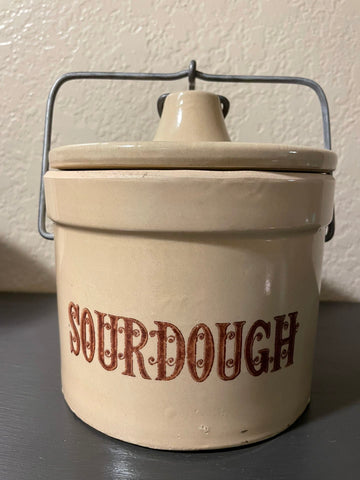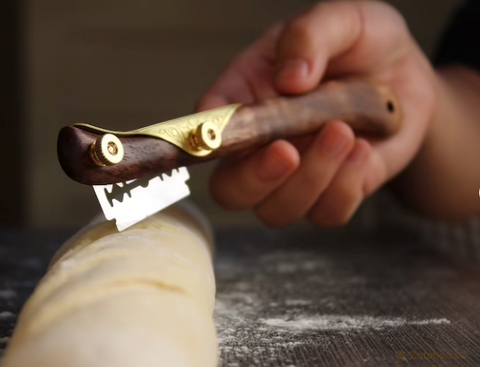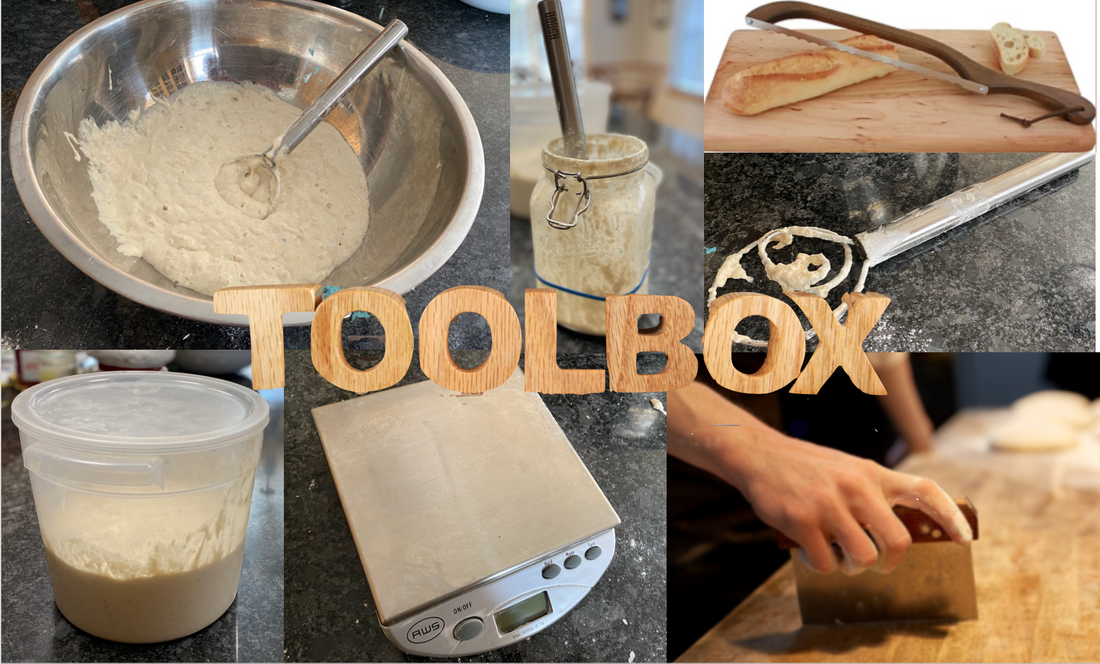When making sourdough bread there is not much equipment you must have; you will likely have the basics. But once you start baking seriously you will probably want more.
Here is a list of equipment and tools I enjoy that you might consider adding to your baking tool box.
Equipment You May Enjoy

Bread Knife (serrated): a good bread knife is serrated and easily saws through crusty loaves without mashing or tearing the loaf.

Personally, I prefer the “fiddle bow” bread saw, which is specialized for just cutting bread. Mine, of course, is made with an Alder handle. Whatever type you use, just be sure it is serrated and saws, not slices, bread.
Bench scraper (metal or plastic): is a rectangular piece of flat plastic or metal that is used to scrape dough from a work surface or to cut the dough into portions for dinner and cinnamon rolls.

These tools are also referred to as bench knives, bench scrapers, board scraper, dough cutter, pastry scrapers or pastry scraper.
“When you work with sticky dough, it can become quite messy as it sticks to the work surface, utensils, and your fingers. A bench scraper keeps your hands out of the dough while you can still manipulate it. You can use a bench scraper for the early stages of kneading a yeast dough when it is still prone to sticking to your hands. Cookie dough is another challenge, and you may want to use the scraper to work with it before you roll it out.”—Jessica Harlan

For home baking 6-Quart and larger work for both dry storage and fermentation, but I have found inexpensive food-grade containers at Wal-mart and our Dollar Store.
I use these to mix and ferment the dough. Lined with a flour-dusted towel they work well as proofing baskets too.

The classic choice is a stoneware crock. I have one that might hold coffee or tea, but drinking neither of these, they could be a great container for growing sourdough.
However, warns King Arthur Baking “Please note! Sourdough starter is a living entity; it needs regular feeding.” Otherwise, it will need to go into the fridge and a crock takes up quite a bit of space there.
Danish dough whisk: also called “brodpisker” in Denmark, is a native tool that replaced wooden spoons centuries ago. Easy to clean, this whisk is strong enough to move through sourdoughs and still be gentle enough to mix pancake batter just right.
Adina Steiman says:
“The Danish dough whisk …really does work some flour-based mojo. Here are just a few of the banes of our existence that this tool has permanently banished:
• No more hard-to-clean spoons
• No more hidden flour pockets or overworked batter
• No more ‘dough gloves’
• No more pockets of raisins”


But my personal choice for home is Barebones cast iron products. These are both great indoors and on the campfire. Their 4 Qt Classic is a heavy-duty cast iron pot featuring a locking lid that seals in steam in for crusty bread.
Still, while most cast iron products work fine and even enamel coated home Dutch ovens work if not overheated (keep it below 450°F (230°C), the best, most versatile cast iron baker is the combo cooker. (pictured below)

"My favorite Dutch oven (or combo cooker, as Lodge calls it) is the Lodge 3.2 quart cast iron combo cooker. I've been using the same combo cooker since I started baking bread many years ago, and it still looks new.This pot is extremely versatile, and I also use it for a myriad of other tasks in the kitchen in addition to baking bread. I frequently use it to make the wonderful Tartine French toast, crispy-bottomed sourdough cinnamon rolls, and the deep end makes a mean roast chicken."—Maurizio Leo, at The Perfect Loaf

Kitchen scale: Serious bakers realize the need for a scale rather than cups for measuring. This will prevent too much or too little flour in a recipe. According to Food52
“Every cook wields a measuring cup differently and even cookbook authors and pastry chefs use them differently from one another. If every recipe included reliable weights, and everyone started using a scale, the overall quality of baking …would improve overnight! “

Lame: You can score bread with any very shape knife, but you will soon find a lame is thinner and much easier for slashing a loaf’s surface. Scoring bread (also know as slashing or docking) bread dough just before it goes into the oven allows the dough expand in the oven without in a controlled way. It also lets moisture escape from the dough as it bakes.
Mixing Bowls: personally I prefer to mix in my bulk container, that way there is less clean up. But for big jobs I use stainless steel. Others like plastic with lids and there are wooden bowls large enough too.
Top of the line are stoneware and glass bowls but be sure they are large enough to hold and mix eight cups of flour or you will have a mess on your hands (and your counter and everywhere else too). Still, most home kitchens have plenty of mixing bowls that will work, just remember to cover them.
Parchment paper has been shown to be the best way to keep bread from sticking to your baking pot or stone. And parchment is a great way to lower dough into a hot Dutch oven without getting burned.
The Spruce Eats says:
“Parchment paper is a heat-resistant, non-stick paper that’s used in cooking and baking. You can line baking sheets and cake pans with it to prevent sticking and reduce browning.”

“A favorite of artisan bakers for raising bread dough. The basket coils provide a beautiful shape and pattern for a traditional hearth loaf look.”— Breadtopia
Sifter: Lucky for us The Spruce Eats has rated the top eight sifters here complete with links to purchase one. Though I have and use a sifter sometimes, I like my small fine-mesh strainer best for flouring my work surface, proofing baskets and loaves.

Thermometer: a meat thermometer works just fine to check and see if your bread has 200°F (93°C) internal temperature before taking it from the oven. There is a good selection on the internet. Personally my choice are Thermapens and Alarm cooking Thermometers from ThermoWorks.
In the comment section below tell us what your favorite kitchen tools are, why you love them and where you got them from.
 Author: Darryl Alder lives with his wife in Riverside Lodge, which is their home, along the Provo River in Utah. He is a retired career Scouter and outdoorsman who spent many hours over a campfire using a Dutch oven and loves sharing recipes for the kitchen and the campfire alike. You can read many of his outdoor recipes here and on this site by searching for Sourdough Saturday or Recipes on the top right-hand side of the blog
Author: Darryl Alder lives with his wife in Riverside Lodge, which is their home, along the Provo River in Utah. He is a retired career Scouter and outdoorsman who spent many hours over a campfire using a Dutch oven and loves sharing recipes for the kitchen and the campfire alike. You can read many of his outdoor recipes here and on this site by searching for Sourdough Saturday or Recipes on the top right-hand side of the blog






